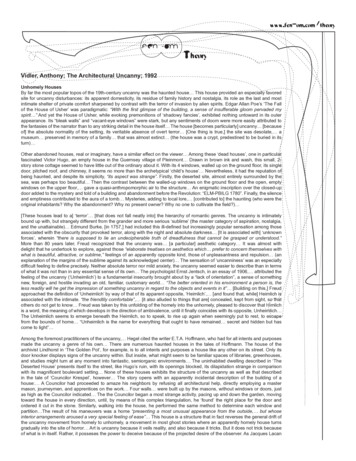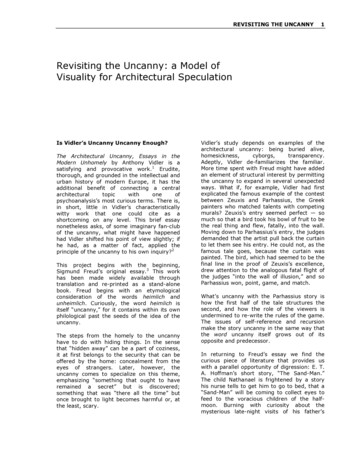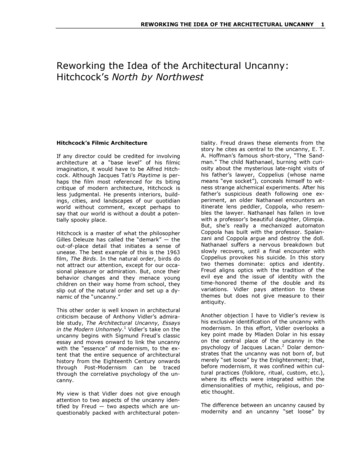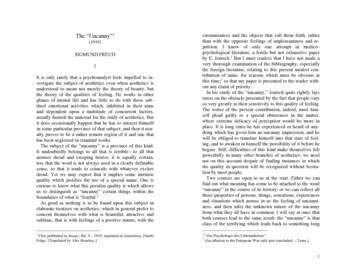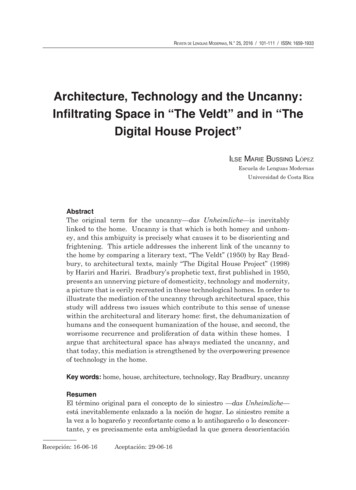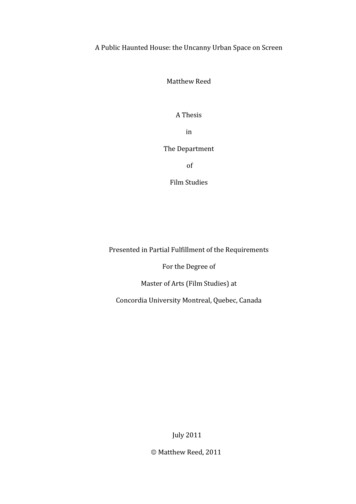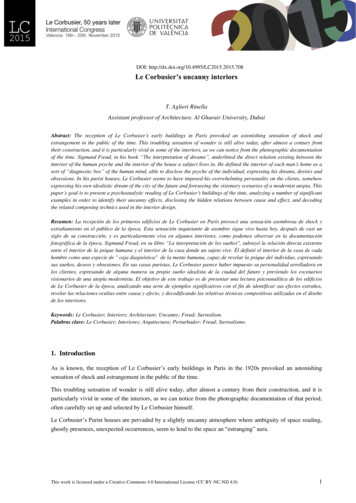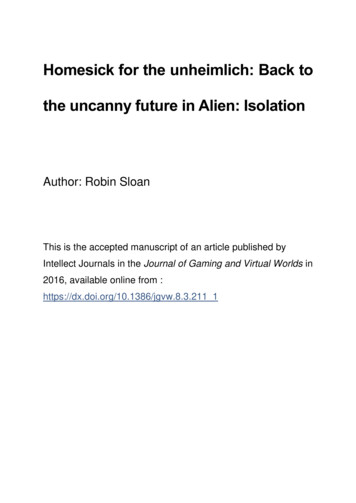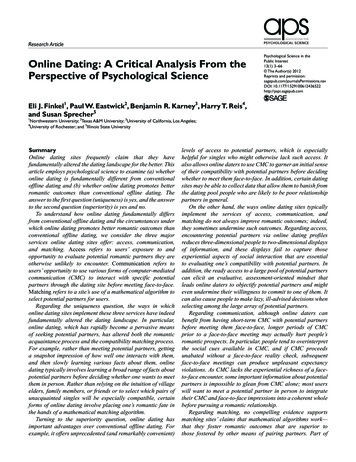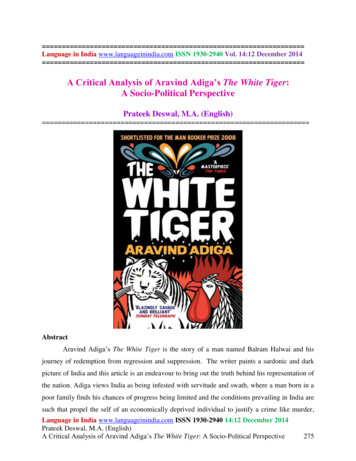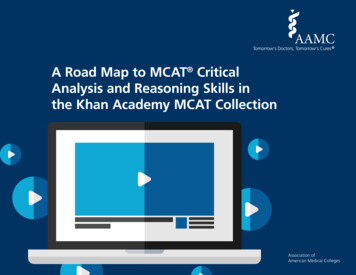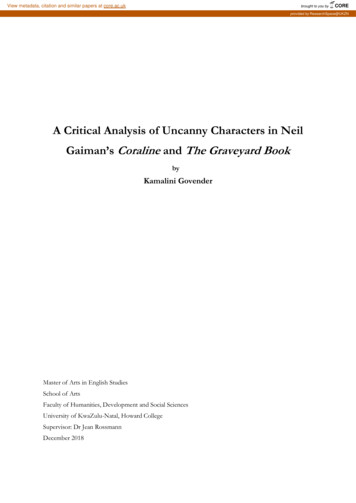
Transcription
View metadata, citation and similar papers at core.ac.ukbrought to you byCOREprovided by ResearchSpace@UKZNA Critical Analysis of Uncanny Characters in NeilGaiman’s Coraline and The Graveyard BookbyKamalini GovenderMaster of Arts in English StudiesSchool of ArtsFaculty of Humanities, Development and Social SciencesUniversity of KwaZulu-Natal, Howard CollegeSupervisor: Dr Jean RossmannDecember 2018
CONTENTSDeclaration . iAcknowledgements . iiAbstract . iiiIntroduction ivChapter 1 – Literature Review1.1 On the Author and Novels 11.2 Critical Scholarship on Coraline . 21.3 Critical Scholarship on The Graveyard Book . 5Chapter 2 – Methodology and Theoretical Concepts2.1 The Uncanny 72.2 The Jungian Shadow 132.3 Liminality, Thresholds and Border Theories 16Chapter 3 – An Uncanny Witch: An Analysis of Liza Hempstock in The Graveyard Book3.1 “They say a witch is buried here.” .203.1.1 An Introduction to Liza Hempstock .203.1.2 “Something girl-like. Something grey-eyed.”: Liza as an Ambivalent Figure . 223.1.2.1 Liza as a Ghost-Witch-Child 223.1.3. “Got no headstone Might be anybody. Mightn’t I?”: Liza as an Unhomely Figure .293.1.4 “One of us is too foolish to live, and it is not I.”: Liza’s Effect on Bod’s Shadow . 33Chapter 4 – An Uncanny Beldam: An Analysis of the Other Mother in Coraline4.1 “Her eyes were big black buttons.” 424.1.1 A Description of the Other Mother: Basic Character and Plot Summary 434.1.2 “Something to love something to eat.”: The Other Mother’s Ambivalenceand Castration 464.1.3 “Like a tired butterfly.”: Doubles and Subjectivity 544.1.4 The Other Mother’s Effect on Coraline’s Shadow .57Chapter 5 – Uncanny Connections from North to South: Gaiman and Human’s Children’sGothic
5.1. A Space for Uncanny Characters and Children’s Gothic in South Africa .685.1.1 A Short Comparison of Human and Gaiman’s Use of Uncanny Characters .695.1.2 A South African Gothic .705.1.3 The Current State of YA Literature in South Africa .715.1.4 Gothic as Solution to “Spiritual Insecurity” in South Africa .725.1.5 Moving Forward with Uncanny Characters in Children’s Gothic Fiction .76Conclusion .78Bibliography .79-92
iDECLARATIONI, Kamalini Govender (203504205), declare thati)The research reported in this dissertation, except where otherwise indicated, is myoriginal work.ii)This dissertation/thesis has not been submitted for any degree or examination at anyother university.iii)This dissertation/thesis does not contain other persons’ data, pictures, graphs or otherinformation, unless specifically acknowledged as being sourced from other persons.iv)This dissertation/thesis does not contain other persons’ writing, unless specificallyacknowledged as being sourced from other researchers. Where other written sources havebeen quoted, then:a) their words have been re-written, but the general information attributed to themhas been referenced;b) where their exact words have been used, their writing has been placed insidequotation marks, and referenced.v)Where I have reproduced a publication of which I am an author, co-author or editor, Ihave indicated in detail which part of the publication was actually written by myself aloneand have fully referenced such publications.vi)This dissertation/thesis does not contain text, graphics or tables copied and pasted fromthe Internet, unless specifically acknowledged, and the source being detailed in thedissertation and in the References sections.Signed:Date: 07 December 2018Kamalini Govender (203504205)Submitted in partial fulfilment of the requirements of the degree of Master of Arts in EnglishStudies in the School of Arts, University of KwaZulu-Natal, Howard College.As the candidate’s Supervisor I have approved this dissertation/ thesis for submission.Signed:Dr Jean RossmannDate: 07 December 2018
iiACKNOWLEDGMENTSThe writing of this thesis would not have been possible without the support and love of my parents(thank you for not being like the Other Mother and Other Father): my dad for opening the worldof books and imagination to me since I was a little girl, and my mother (the scorpion) whose loyaltyand sting have prepared me for my many adventures as a woman in this world. To my siblings byblood and marriage (Sudeshan, Kiasha, Sharika and Ushir) and niece princesses (Aryana andTahlia), who are constant sources of random information, light and laughter: my ‘warg’ packforever and always. My own Cat of the Nameless, and constant muse, you allow me to enter theOther Side effortlessly and your paw prints are uncannily all over these pages.My gratitude to Matt, Monster Slayer, who taught me to level up no matter how tough life gets.To Jeremy, mentor and guardian, who took a chance on me as a teacher and allowed me to find aplace for these ideas, there are no right words except maybe “the warrant is all”. To mybalcony ‘friend’ that cheered and spoke words of motivation during the toughest portion of thisthesis, thank you for letting me “put your eyes in a jar”.I would also like to take this opportunity to thank the University of KwaZulu-Natal, especially mysupervisor, Dr Jean Rossmann, for her dedication, attention to detail and hard work in assistingme in the completion of this thesis. An extra special grazie to Mrs Bellusci for her academicguidance and valuable wisdom.“I believe that in the battle between guns and ideas, ideas will, eventually, win. Because the ideasare invisible, and they linger, and, sometimes, they can even be true.” (Gaiman 2016: 8)
iiiABSTRACTIn this dissertation I examine uncanny characters in Neil Gaiman’s novels Coraline (2002) and TheGraveyard Book (2008). I explore what constitutes uncanny characters in his narratives and theconsequent effects these characters have on protagonists’ identities: their self-awareness andacknowledgement of alterity. Both novels have been classified under an experimental genre,Children’s Gothic, known for negotiating identity, making use of elements of horror and usingallegorical versions of contemporary cultural debates (Jackson 2017). While critics like RichardGooding (2008) and David Rudd (2008) have explored the uncanny in Coraline for its adolescentmaturation and identity formation, dependent on traditional psychoanalytic paradigms ofseparating the child from the mother figure, I rely on contemporary re-readings of SigmundFreud’s “uncanny” (1919) in conjunction with Carl Jung’s notion of “the shadow” to reveal howprotagonists in Gaiman’s two novels gain self-awareness and an acceptance of ‘the other’. Throughan analysis of the ghost-witch-child, Liza Hempstock in The Graveyard Book, and the beldam orOther Mother in Coraline, I reveal how their uncanniness (ambivalence, uncertainty andunhomeliness) blurs binarist notions of good/evil as well as hegemonies of gender, race andreligion. As a ghost from the Elizabethan era, Liza reveals the presence of the past and forms ofpersecution and violence that are transhistorical (witch-hunts, child oppression and Antisemitism).Not dissimilar to Liza, I argue that the Other Mother’s doubling and ambivalence (good/evil,mothering/malign, human/monster) provides a powerful, transgressive alternative to limitingpatriarchal definitions of the feminine. Both the Other Mother and Liza thus challenge oppressiveforms of thinking and become catalysts for positive change in the protagonists’ sense of self. Anunderstanding of how the uncanny works will assist readers in coming-to-grips with social anxietiesinvolved in living in a multiple society, in which one is constantly confronted by alterity. Gaiman’snovels teach lessons in transforming the fear of the other into a moment of possibility. For thisreason, I argue that Gaiman’s novels are relevant to the South African milieu, and share similaritieswith certain South African Children’s (or Young Adult) Gothic novels, such as Charlie Human’sApocalypse Now Now (2013). Through a comparison of uncanny characters in Human’s andGaiman’s novels, I argue for a space for Children’s Gothic in the South African literary landscape.Through uncanny characters, Gothic has the unique capacity to co-opt young readers into theprocess of disrupting borders, renegotiating identities and bringing about individual and culturaltransformation.
ivINTRODUCTIONThe following dissertation critically examines uncanny characters in Neil Gaiman’s novels Coraline(2002) and The Graveyard Book (2008). The purpose is to understand how Gaiman’s charactersembody and exemplify the uncanny and what effects these characters have on the protagonists’identities: their self-awareness and acknowledgement of alterity, of gender and cultural diversity.Both Gaiman’s texts may be classified under a fairly recent genre in children’s literature1 known as“Children’s Gothic,” an experimental genre recognised for exploring negotiations of identity,elements of horror and allegorical versions of contemporary cultural debates (Jackson 2017: 1). Asan extension of the eighteenth-century Gothic genre, Children’s Gothic shares the former’spenchant for transgression: “[g]othic terrors activate a sense of the unknown and project anuncontrollable and overwhelming power which threatens not only the loss of sanity, honour,property or social standing but the very order which supports and is regulated by the coherenceof those terms” (Botting 1996: 7). Common to the Gothic genre, Children’s Gothic and Gaiman’snovels make use of “transgression” through uncanny characters, ones that subvert traditionalstereotypes found in both Gothic and children’s literature. Liza Hempstock, the ghost-witch-child,in The Graveyard Book, and the doppelgänger Other Mother in Coraline, portray ambivalent andhybrid identities that I argue exemplify aspects of Sigmund Freud’s psychoanalytical concept of“the uncanny” or “Das Unheimlich” (1919). My study thus addresses an occlusion in scholarshipon these novels by focusing on Gaiman’s uncanny characters, rather than his uncanny settings(portal doors and graveyards) (Gooding 2008; Rudd 2008; Stephens 2012). Furthermore, followingChloé Buckley, I argue that Gaiman’s protagonists defy “monologising” discourses of childhoodthat utilize a “limiting psychoanalytic framework” (2018a: 45, 42). Buckley insists that Coralineholds up a mirror “to critical discourse and cultural ideas about childhood” (43). In agreementwith Buckley, I argue that Gaiman introduces complexity and multiplicity into his representationsof childhood. As Buckley notes, the openness of Gaiman’s texts precludes a kind of a priori ‘paintby numbers’ psychoanalytical reading. While Buckley denounces reductive readings, she does notdenounce theory, or psychoanalysis entirely. Bearing Buckley’s caution in mind, I read Gaiman’snovels through the lens of recent studies of the uncanny that focus on the concept’s capacity toconstantly shift and de-stabilise meaning. I argue that uncanny figures such as Liza and the OtherMother have a destablising effect on the protagonists, causing them to enter a liminal stage wheretheir identities become more fluid. It is in this liminality, and through facing the duality of theseChildren’s literature is a genre that encompasses texts made for children, usually to educate and instruct the childon values of good behaviour, the importance of following rules and rejecting vice. Interestingly, it has been arguedthat the genre was formed as a response to the view that Gothic texts are unsuitable for children. See DaleTownshend, (2008), “The Haunted Nursery 1764-1830”.1
v‘others’ that the protagonists encounter their “shadow,” a repository of repressed ideas, beliefs orprojected fears that can prevent self-awareness (Jung 1958). Making the texts my primary focus,but also through engaging with contemporary re-readings of the uncanny and Jungian theory, it ispossible to interpret Gaiman’s novels in a new, culturally relevant light (Royle 2003; Bernstein2003).The inspiration for my research originates from observing positive effects on students learningEnglish as a foreign language. From 2013 to 2016, I noticed Coraline and The Graveyard Book assistedreaders in working through anxieties and cultural stereotypes in classroom environments. Thissparked my interest in the genre of Children’s Gothic and applications of the uncanny to Gaiman’snovels (predominantly Coraline, which is seen as a canonical representation of the Children Gothicgenre and uncanny children’s fiction).2 In what is now considered to be a seminal text on thesubject, The Gothic in Children’s Literature: Haunting the Borders by Karen Coats, Anna Jackson andRoderick McGillis, Coats considers the popularity of Children’s Gothic with young readers as aresponse to “an underlying trauma” in contemporary society (2008: 77). She suggests that traumais a natural part of a child’s experience and that children are given the opportunity through literarytexts like Gaiman’s to work through their traumas on a psychical level. Coats focuses on the traumaof change in Coraline (separation from a parent figure or the fear of abandonment) that a youngadult must typically overcome to successfully integrate into society.For Coats, the appeal of Gaiman’s novels lies in the fact that he “does Gothic old-school, that is,the demarcations between good and evil are clear, and even when the evil is within, it is soundlydefeated and expelled by a problem-solving hero or heroine” (Coats et al. 2008: 77). From whathas been witnessed in foreign language classrooms, Coats’s assertion seems limited in conveyingthe scope of Gaiman’s impact, especially in environments where such “clear” demarcations nolonger exist due to a rise in danger, increased access to mature content online and politicalinstability which has become a world-wide phenomenon (McGillis 2008). Children’s Gothic withits use of uncanny characters is advantageous because it challenges the notions of a “stable” or“knowable” child, typical of children’s literature criticism that fails to see the child protagonist asa multiple, complex being: one with many reactions and exposed to a variety of socio-economicand political experiences (Rose 1984: 1). This study contributes to current scholarship on Gaiman’stexts by relying on scholars such as Buckley, who view “identity as an open-ended process” (2018:For a comprehensive study on Coraline as a canonical text see Chloé Buckley, (2015), “Psychoanalysis, “Gothic”Children’s Literature, and the Canonization of Coraline”.2
vi47). My contribution to studies of Gaiman’s novels aims to reveal how Gaiman’s protagonistslearn, through trial and tribulation, that the ‘other’ is an extension of themselves. The concept of‘the other’ is defined as “[t]he quality or state of existence of being other than or different fromestablished norms and social groups” (Wolfreys 2011: 345). Otherness is thus based indifferentiation between the self and another, and is especially problematic when dealing with issuesof sexual, racial and ethnic difference. By allowing protagonists to develop a self-aware and openminded approach to relationships with the self and community, protagonists’ understanding ofhow they perpetuate otherness may be understood and overcome.Chapter OutlineThe following dissertation is divided into five chapters. The first chapter provides information onthe author, Neil Gaiman, with brief synopses of Coraline and The Graveyard Book. In this section Ialso discuss current critical debates surrounding both novels as is pertinent to my analysis; namely,the use of Gothic tropes, liminality, feminist perspectives and the use of the uncanny.The second chapter provides detailed explanations regarding theoretical concepts that I use toexamine Gaiman’s novels; namely, the uncanny, the Jungian shadow and liminal or thresholdtheories in literature. Freudian understandings of the uncanny posited alongside contemporarynotions of the concept allow for a distinct break from traditional sexual or biologicalinterpretations (Royle 2003; Bernstein 2003). Most importantly, contemporary theories on theuncanny disrupt totalising viewpoints within psychoanalytic criticism and scholarship on children’sliterature. Contemporary revisions of the uncanny also allow Gaiman’s texts to be read via apostcolonial lens. As will be discussed, I apply Homi Bhabha’s concept of the unhomely (1992) tosuggest how Gaiman calls attention to the marginalised, exiled ‘other.’ Aspects of postcolonialismare inherent in the Children’s Gothic genre with its navigation of contested spaces, hybrid identitiesand recognition of marginalised individuals. In relation to my study, it can be important in assistingself-awareness that leads to culturally inclusive, less prejudiced protagonists and child readers. Ihope to prove the applicability of postcolonial readings of the uncanny in my final chapter on therelevance of Gaiman’s texts to a South African context.The Jungian shadow, as applied to current social situations and as a tool in dismantling ideologicaland political beliefs, will also be foregrounded in this chapter. As the uncanny is the primary focus
viiof this thesis, the shadow archetype3 will be dealt with to a lesser degree, thus leaving room forfurther studies on the relationship between the shadow and identity in both texts. I recognise theunlikely pairing of Freudian and Jungian ideas might be considered heretical, due to notoriousdisagreements between the two psychoanalysts’ approaches to the nature of shadows and whatcomprises the unconscious. Lastly, in this chapter, I discuss theories of liminality, as it applies toYA and children’s literature. I advocate the use of “nomadic subjectivity” (Buckley 2018a) toexplore ways in which a protagonist transcends demarcated borders, accepts hybrid spaces andturns the negative perception of a wandering existence into one of empowerment and selfrealisation.The third chapter presents a critical analysis of the first of two uncanny characters I will beanalysing in Gaiman’s novels: Liza Hempstock, the ghost-witch-child. Due to a lack of scholarshipon this character, I present what may be perceived as an unorthodox claim that Liza reflects aspectsof postcolonial marginalisation and exile as an uncanny figure: as an oppressed/murdered child, apersecuted witch and as a potential Jewish character. I argue that Liza’s ambivalence and“unhomeliness” (Bhabha 1992) allow her to trouble and challenge socially constructed boundariesof patriarchy and religion. I examine how Liza may be perceived as a creative and dynamic sourceof energy that assists the protagonist in encountering important aspects of his shadow that maylead to self-awareness.The fourth chapter examines the Other Mother, or beldam, in Coraline. In this chapter I argue thatthe Other Mother is an ambivalent, and even, to some extent, relatable character. Through heruncanniness and status as a double, she has the ability to undo binaries inherent in the process ofothering. As a powerful and potentially dangerous woman, she subverts patriarchal definitions ofthe feminine that limit and restrict women. In addition, the Other Mother reveals to Coraline theinseparable dialectic between self and other within each of us. While the Other Mother’s intentionsare felt to be sinister, as she tries to ease Coraline’s acceptance of her, Coraline is also forced torecognise the potential for duality in each person. I argue that the Other Mother is a “nomadicsubject” (Buckley 2018a) whose multiple subject positions provide Coraline with a transgressivemodel of femininity.The archetype is defined as an invisible storehouse of psychic energy or “dynamic nucleus” with the potential tomanifest into symbols. See Jolande Jacobi, (1959), Complex/ Archetype/ Symbol in the Psychology of C.G. Jung.3
viiiThe final chapter of my thesis argues for the relevance of Gaiman’s novels to the South Africanmilieu. Despite Children’s Gothic not being recognised as a genre in South Africa, I argue it canbe utilised by young readers in negotiating or transforming identity by comparing Gaiman’s TheGraveyard Book to South African author, Charlie Human’s novel Apocalypse Now Now (2013). Icontend the hybrid nature of Children’s Gothic, with its mix of mythology, fairy tales and Gothicelements, is an appropriate genre to express the complexities of current South African postcolonialidentities. If Gaiman’s novels offer a transformative space for young readers engaging withquestions of identity, then what possibilities are there for South African authors who similarlymake use of uncanny characters and the Children’s Gothic genre?
1Chapter OneLiterature Review1.1 On the Author and NovelsNeil Gaiman is a British author, famously recognised for his dark fantasy DC comic book seriesThe Sandman (1989 - present). As an avid supporter of human rights,4 Gaiman is also a firm believerin writing for unintended audiences, that encompasses variety, hence the popularity of his novelsto children, adults and those of different cultures. While originally seen as a fantasy and sciencefiction writer for an adult target audience, with his novels American Gods (2001) and Stardust (1999),he has since become popular with his children’s or Young Adult5 texts such as Coraline, TheGraveyard Book, Odd and the Frost Giants (2008) and his more ambiguously categorised The Ocean atthe End of the Lane (2013). Gaiman has won numerous awards, including the prestigious Newbery(2009) and Carnegie (2010) medals, along with the Nebula (2004) and Hugo (2003) awards for hischildren’s fiction.Coraline follows the pre-adolescent journey of a bored young girl who moves into a new apartmentand subsequently finds a door leading to an eerie replica of her real home. She meets doubles or“other” parents who are extremely loving and attentive in the other world yet possess creepy blackbuttons for eyes. She eventually learns that her Other Mother6 (or beldam) wishes to keep her inthe other world forever and she attempts to leave. However, the beldam kidnaps her real parentsand Coraline must go on a brave quest amidst trapped ghost children, deformed sac-like versionsof her neighbours and a disintegrating world to save her parents and return home before the startof the new school year. The Graveyard Book, on the other hand, features a toddler whose family isbrutally murdered by a sinister figure at the onset of the novel. Bod, as he is eventually named, iswelcomed by the ghostly inhabitants of a nearby graveyard and reared by a mysterious nightwalker(presumably a vampire). He subsequently learns the necessary survival skills (of his supernaturaland real worlds) to defeat his enemies and grow into an independent young man. Both novels areknown to be inspired by fairy tale motifs and pay homage to popular children’s classics: Coraline toLewis Carroll’s Alice’s Adventures in Wonderland7 (1865) and Lucy Clifford’s short story “The NewMother” (1882), while The Graveyard Book echoes Rudyard Kipling’s The Jungle Book (1894) (BuckleyGaiman is a Goodwill Ambassador for UNHCR (United Nations Refugee Agency) since 2017.Henceforth to be referred to as YA.6 In contrast to the novel, I capitalise the Other Mother’s name, to highlight her significance as a character deservingsubjectivity. The other father will remain uncapitalised.7 Hereafter to be referred to as Alice.45
22015; Abbruscato 2014). Gaiman’s overt use of intertextual allusions, allowing him to create newworlds from familiar material, has been noted as one of the many reasons his novels appeal toracially and culturally diverse audiences (Burdge and Burke eds 2012; Rodrigues 2012). Indeed, Iargue that, Coraline and The Graveyard Book are particularly relevant to a South African context, asthey assist child readers in coming-to-grips with social anxieties involved in living in a multiplesociety, in which one is confronted by different modes of being, as well as different belief systemsand values.1.2 Critical Scholarship on CoralineDue to a concern with “the darker side of life” and similarities with the children’s classic, Alice,Coraline is distinguished from a majority of children’s novels, as reflecting the current “appetite”or popularity of Children’s Gothic fiction in the twenty-first century (Coats 2008: 77; Rudd 2008:2; Buckley 2015). The novel is noted for its aptness in reflecting the transitions of childhood, andits appeal to younger audiences has thus won it numerous awards (Hugo (2003), Nebula (2004),the Bram Stoker award (2002) and the British Science Fiction award (2003). Gaiman’s novels wereoriginally considered “too scary for children;” however, Gaiman himself comments on the factthat children enjoy the suspense created in his novels, and do not respond the same way as adults(Gaiman 2016: 91). The novel’s popularity and appeal is evident in its adaptation as an animatedfeature film by Henry Selick (2009), and as a stage musical by Leigh Silverman (2009). Scholarshipon Coraline is wide-ranging. It has been subject to psychoanalytical readings (Gooding 2008; Rudd2008; Agnell 2014); readings that investigate its Gothic tropes (Coats 2008; Buckley 2015); feministinterpretations (Parsons et al. 2008; Wilkie-Stibbs 2013); and readings that use theories of liminality(David 2008; Perdigao 2014). Additionally, studies have looked at Coraline as a reworking ofpopular children’s classics from Alice to the Narnia chronicles by C.S Lewis (Buckley 2010; Godfrey2015). The novel has also been explored from a translation studies perspective, in terms of its dualreadership (Segers 2012); and from the perspective of developmental psychology, using the theoryof “cognitive dissonance” (Palkovich 2015).Of interest to my study, is firstly, how Coraline exhibits Coats’s response to the popularity ofChildren’s Gothic texts as expressing “incongruent stimuli” that assist the protagonist and childreader in their psychical development (Coats 2008: 84). The protagonist deals with “incongruentstimuli” in a variety of ways. In my application of Jungian theory, Danya David’s (2008) linkbetween ambiguous boundaries and Coraline’s use of language, art, intuition and dreams will proveuseful in the protagonist’s journey of self-growth, as the role of dreams and intuition resonate with
3Jung’s notions of the archetype, the shadow and journeys of self-discovery. Rudd’s observation ofthe uncanny in Coraline is also particularly helpful in rethinking the protagonist’s negotiation ofidentity (2008). According to Rudd, it is the “creepy uneasiness” of the uncanny other world thatallows Coraline to come face to face with her deepest desires (1). Rudd also notes Coraline’s affinityto darker fairy tale narratives, that together with the uncanny, creates a suitable environment forCoraline to explore her identity. However, he goes on to analyse the uncanny through a Lacanianlens, relating the Real, Symbolic and Imaginary8 to Coraline’s realisation of her true desires andindividuality. While useful on many levels, I find the overall impression of the uncanny as inducingfear related to the “fragility of one’s existence” unhelpful in my aim to prove the protagonist’s selfaffirming and positive engagement with the world (15). Therefore, I rely on Jungian theory tocounter Rudd’s emphasis on existential issues in Coraline, and to show how the uncanny can beread with psychological concepts other than Lacan’s RSI that focus purely on Coraline’s isolation.I argue that the Other Mother need not be “set aside in order to live,” instead Coraline learns waysof integrating aspects of the Other Mother that focuses on similarity (15).Additionally, Richard Gooding’s study is insightful in noting how the uncanny is used in Coralinevia narrative structures that defy traditional fantasy stories for children, in which the protagonistalways returns to the safety and comfort of home after expelling a necessary evil. For Gooding,the use of portal narratives that blur reality and fantasy spaces allows the protagonist to embarkon a quest of maturation and self-awareness (2008: 400) Instead, I shall apply the uncanny toGaiman’s characters in order to reveal the importance of defying traditional children’s tales andwhy liminal zones assist the protagonist’s psychological development. In terms of applications ofthe Jungian shadow in Coraline, there is one marked study that briefly interprets the Other Motheras Coraline’s shadow (Garud 2011). I refrain from seeing the Other Mother as a metaphoricalshadow; rather, she nurtures and allows the protagonist to realise aspects that lie within theprotagonist’s shadow self.Einat Natalie Palkovich’s examination of cognitive dissonance, whereby traditional children’sliterature characters are split into a good mother and bad mother, is valuable in showing howfamiliar expectations are disrupted in the protagonist, who must find a way to resolve the unknowninto the known (2015: 182). Palkovich argues for the importance of separating the protagonistBriefly, Jacque Lacan’s model of the RSI (Real, Symbolic and Imaginary) is a representation of psychologicalphenomena. The Real is that which is unsymbolised or imperceptible, yet crucially tied to the development ofmeaning. The Symbolic reflects the representation of ideas, whilst the Imaginary deals with “sensorial perception”and the ability to conceptualise meanings to their words/ images. See Lionel Bailly, (2009), “Real, Symbolic,Imaginary”.8
4from the ev
an analysis of the ghost-witch-child, Liza Hempstock in The Graveyard Book, and the beldam or Other Mother in Coraline, I reveal how their uncanniness (ambivalence, uncertainty and unhom
